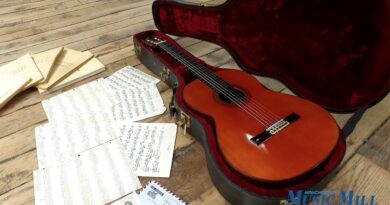The Perfect Sound for the Classical Guitar | Scheller
Every guitarist in the world shares the same obsession and passion for the quest of the perfect sound.
In this video, Scheller is very please to present the historical instrument expert and classical guitar player Wulfin Lieske.
Wulfin Lieske shares his perspective on this holy quest of sound, after more that 40 years of experience in the industry.
This testimonial is a comprehensive overview of what truly matters when it comes to developing one’s own unique sound.
Scheller designs and produces high end guitar tuners made in Germany. Visit their website to discover their products.
https://gitarrenmechaniken.com/
A Scheller Gitarrenmechaniken Production.
Filmed by Néné Photographie
#Perfect #Sound #Classical #Guitar #Scheller
Originally posted by UClJaIM4d-gpXj7z-8AYDLkw at https://www.youtube.com/watch?v=d_7PSCsvgN4




Thank you sir.
Maestro Hubert Käppel hat es sicherlich gehört, bin gespannt auch auf seine Meinung. Ich fand es jedenfalls sehr nützlich ????
perfect sound for guitar according to him ? have money … pretty elitist and snobish take if you ask me
Almost any guitar from 500 euro upward sounds good if played well.
I'm an aging Kiwi, hobby luthier and folkie. Many years ago, a guy who had a mandolin. Stuck a blob of blue tack onto the machine head, end of his mandolin. immediately the mandolin sounded, quite different, with lots more sustain.
I always judge (used classical) guitars by its resonance harmonics, overtones and volume/attack on the hammer on (besides the obvious intonation accuracy and action) As a result, I keep running into pawn shop guitars for cheap worth thousands. At least in Midwest America, the pawn shops are so much into electric/metal, they treat classical as out-of-fashion secondary "beginner" and don't really do their research.. My best find was 1970s Juan Alvarez cedar blanca flamenco worth $5000 for $125, a 1970s Korean Brazilian rosewood for $200, sells for $2000 and a 120 yo mandolin, solid Brazilian rose wood for $120,
I never would have known how much difference the machines would make. This was such an unexpected insight. I'm happy that you didn't consider this a corruption of your instrument when in fact it brought new life to it! Thx for sharing.
Percussive guitar:
https://m.youtube.com/@MarcinGuitar/playlists
Well done. Thank you. Held me to the end
Wonderful explanation and presentation. Thank you a lot fot this! Best regards from me!!!
Analysis is paralysis.
Great vid. I’m mostly a fingerstyle steel string player but I have decent Classical. I know when my nails are not smooth as I hear it on the classical. I enjoy trying out different strings but I’m hooked on Savarez 500AJ High Tension Composites. The trebles strings don’t have the plasticy sound of nylon trebles. Also the finish of the guitar is a big factor. French Polish vs Lacquer.
Muchas gracias, Gray insight about our holy grial , the sound.
I started using cheap DAddario strings in my classical guitar and its sound was not that great, it felt it was missing some frequencies, but I went from that to some Hannabach 815MT and Jesus Christ, the bass sounds so much better, is like having a harpsichord in the lower strings or a lute, the sound is clear but a bit metallic in a good way, for the lower strings they are stupidly clear compared to the cheap dAddario for sure 🙂
Well you could exchange the 3rd only just to check if it is sufficient. Still best result provides the entire set, the SAVAREZ did their best to harmonize it all well
I play what is identified as a 'beginner's' classical guitar (Yamaha CG122MCH). However I do not play classical music, rather folk, ballads, some country, etc.
I find my guitar works well for me as a beginner so far. I do have a question about the G string. It just does not sound musical; reminds me of something found on a toy guitar. I changed out the original strings (Yamaha S 10, trebles high, basses medium) for a set of D'adarrio EJ 25, normal tension strings but it didn't help. I'm not sure what, if anything, I should try next. It's possible of course that it could be a case of operator error, but the other strings sound fine. Any advice? Suggestions? Anyone?
Beautiful????
wonderful guitars you have here. sadly, 95 or more percent of the guitars in the world have mediocre or even bad tuning machines, such an underrated aspect of a guitar
It appears the tuning machines are on backwards and should be reversed. This can be done next string change, no big deal. I enjoyed your discussion.
A lot of useful information—but you may have forgot the most important thing—the soul of an artist–that intangible quality that combines the necessary mechanics with something drawn from deep within one's soul—-not necessary to have an expensive guitar—just an ordinary guitar that is set up correctly. When you encounter a player that has the soul of an artist it is overwhelming.
I am grateful for your insight. I just found you on YT and I am happy I did.
Mr Wulfin, what's the name of the piece you played?
How can I learn more from you?
Bravíssimo master.
Wow very interesting and great sound from the Santos. I wonder how this relates to pegs and mechanical pegs eg Wittner or Perfection pegs, and also headstock design.
Ah! Scheller not Schaller. Had me confused for a while… ????
Wulfin, what guitar book do you have ?
Thanks, that sound very challenging – could you provide some details/background etc.? Best regards Wulfin
Wulfin, Are you going to visit Colombia some day, and willing to play with our Symphonic orchestra??